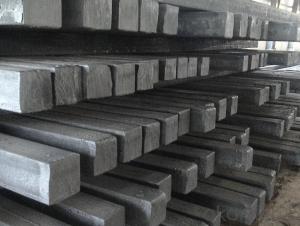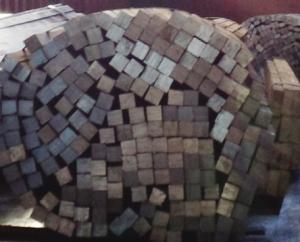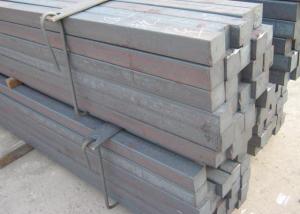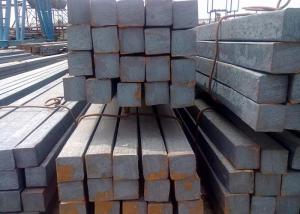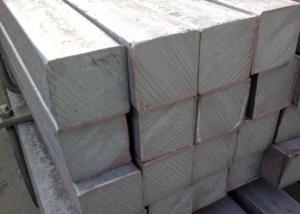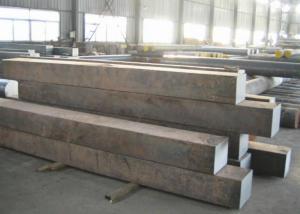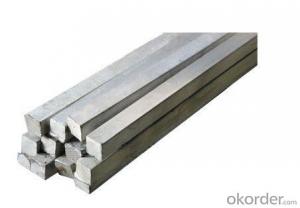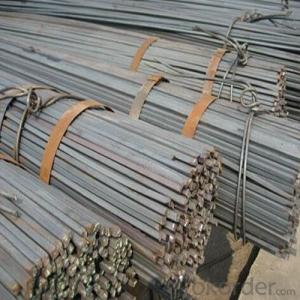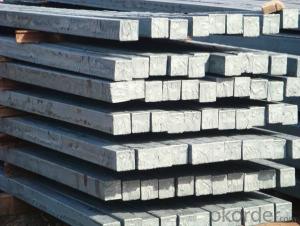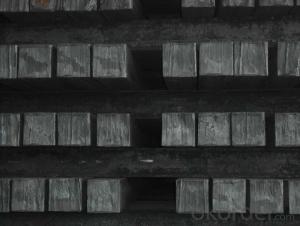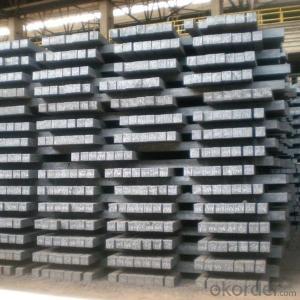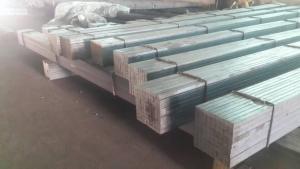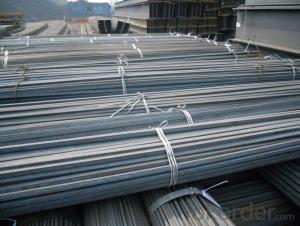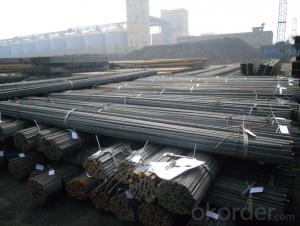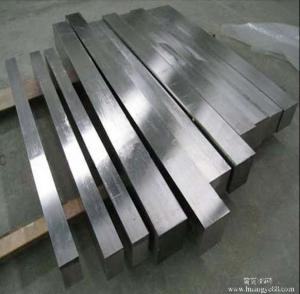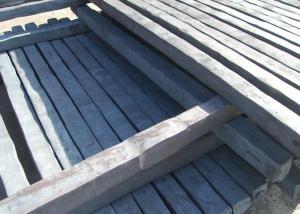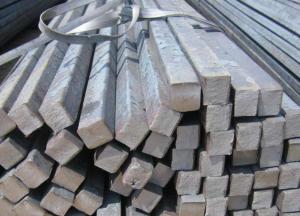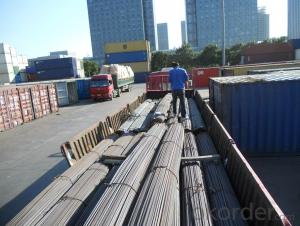hor rolled steel billet
- Loading Port:
- China Main Port
- Payment Terms:
- TT OR LC
- Min Order Qty:
- -
- Supply Capability:
- -
OKorder Service Pledge
OKorder Financial Service
You Might Also Like
Product Description:
We offer Square Steel Bar with grade Q195 / Q235
Specifications of Square Steel Bar:
-Standard: GB,
-Grade: Q195/Q235 or equivalent.
Chemical Composition:
-Chemical Composition. Q195
Standard | Grade | Element (%) | ||||
GB | Q195 | C | Mn | S | P | Si |
0.06~0.12 | 0.25~0.50 | ≤0.050 | ≤0.045 | ≤0.30 | ||
-Chemical Composition. Q235
Standard | Grade | Element (%) | ||||
GB | Q235B | C | Mn | S | P | Si |
0.12~0.20 | 0.30~0.70 | ≤0.045 | ≤0.045 | ≤0.30 | ||
Measures and Tolerances of Square Steel Bar:
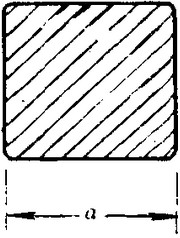
(The section of Square Steel Bar)
-The length of a side and the theoretical weight of Square Steel.
Length of a side(a, mm) | Theoretical weight(kg/m) | Length of a side(a, mm) | Theoretical weight(kg/m) |
6 | 0.283 | 32 | 8.04 |
7 | 0.385 | *33 | 8.55 |
8 | 0.502 | 34 | 9.07 |
9 | 0.636 | *35 | 9.62 |
10 | 0.785 | 36 | 10.17 |
11 | 0.950 | 38 | 11.24 |
12 | 1.13 | 40 | 12.56 |
13 | 1.33 | 42 | 13.85 |
14 | 1.54 | 45 | 15.90 |
15 | 1.77 | 48 | 18.09 |
16 | 2.01 | 50 | 19.63 |
17 | 2.27 | 53 | 22.05 |
18 | 2.54 | *55 | 23.6 |
19 | 2.82 | 56 | 24.61 |
20 | 3.14 | *58 | 26.4 |
21 | 3.46 | 60 | 28.26 |
22 | 3.80 | 63 | 31.16 |
*23 | 4.15 | *65 | 33.17 |
24 | 4.52 | *68 | 36.3 |
25 | 4.91 | 79 | 38.49 |
26 | 5.30 | 75 | 44.16 |
*27 | 5.72 | 80 | 50.24 |
28 | 6.15 | 85 | 56.72 |
*29 | 6.60 | 90 | 63.59 |
30 | 7.06 | 95 | 70.85 |
*31 | 7.54 | 100 | 78.50 |
Notes:
1, The theoretical weights in the list, base on the density of 7.85 g/cm3.
2, The numbers with *mean that they are not regulars or we don’t offer them.
-The allowed tolerance of Square Steel:
Length of a side(mm) | Allowed Tolerance | ||
Group1 | Group2 | Group3 | |
5.5~7 | ±0.20 | ±0.30 | ±0.40 |
7~20 | ±0.25 | ±0.35 | ±0.40 |
20~30 | ±0.30 | ±0.40 | ±0.50 |
30~50 | ±0.40 | ±0.50 | ±0.60 |
60~80 | ±0.60 | ±0.70 | ±0.80 |
80~110 | ±0.90 | ±1.0 | ±1.1 |
110~150 | ±1.2 | ±1.3 | ±1.1 |
150~190 | ―― | ―― | ±2.0 |
190~250 | ―― | ―― | ±2.5 |
Usage/Applications of Steel Square Bar:
-The Square Steel is normally used as structure steel.
-Row material for other structure steel like steel angles, channels, I-beams, H-beams, etc…
Packaging & Delivery of Steel Square Bar:
-Packing Detail: The products can be packed in bundles by steel wires.
-Marks:
1, Tag marks: the tag marks will be tied up to each bundle of the products. The information is usually including supplier’s logo and name, product name, made in China, products’ specifications, the painted color and other information requested by customers.
2, Color marks: we will paint both ends of the bundles of these products to make sure that they are more evident. It’s will be more convenient for the customers to distinguish them at the destination port.
-Delivery Detail: 30~45 working days after receive buyer’s T.T. or L/C.
Transportation:
-The products can be delivered by bulk vessel or by container. As for container, products with the length of 6m will be loaded in 20’ container, with 9m or 12m, in 40’ container.
-The maximum quantity of loading of container is 25 tons.
-The products usually are transported to the nearest port from the production place.
Payment:
-Invoicing on theoretical weight or actual weight a s customer’s request.
-FOB, CFR or CIF.
-Regular terms of payment:
1, 30% payment in advance, the remaining balance (70% payment) against the copy of B/L.
2, 30% payment in advance, the remaining balance (70% L/C) against the copy of B/L.
3, Negotiable.
Photos of Square Steel Bar:
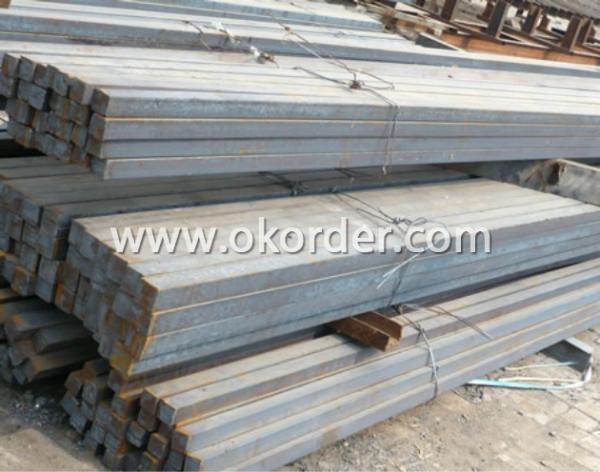
- Q: Can a steel square be used for marking straight lines?
- Certainly! A steel square possesses the capability to mark straight lines. Known alternatively as a framing square or a carpenter's square, this versatile tool finds application in carpentry and other trades. It comprises a lengthy metal blade engraved with measurements and angles, along with a shorter perpendicular metal tongue. The primary function of a steel square lies in ensuring the accuracy of right angles, though it can also serve to draw or mark straight lines. To mark a straight line using a steel square, one can position the blade or tongue against the desired material's edge, ensuring proper alignment. Then, by utilizing a pencil or marking tool, one can trace along the steel square's edge, thereby creating a straight line. By leveraging the straight edges and precise measurements of a steel square, one can accurately mark straight lines on a variety of materials, including wood, metal, or plastic. Nevertheless, it is crucial to note that while a steel square may be employed for marking straight lines, it may not be as convenient or efficient as other tools specifically designed for this purpose, such as a ruler or a straightedge. The large size and weight of a steel square can render it unwieldy for smaller or intricate markings. Furthermore, if the material being worked on is not flat or possesses irregular edges, achieving a perfectly straight line using solely a steel square may present more challenges. In conclusion, while a steel square can be utilized for marking straight lines, it is generally advisable to employ it for verifying right angles and resort to specialized tools for precise and efficient marking of straight lines.
- Q: Can a steel square be used for drywall corner installation?
- Yes, a steel square can be used for drywall corner installation. A steel square is a versatile tool that is commonly used in carpentry and can also be utilized for various tasks in drywall installation, including marking and cutting corners. By using a steel square, you can ensure accurate and precise measurements, which is crucial for achieving seamless and professional-looking corners in drywall installation.
- Q: Can a steel square be used for drawing straight lines?
- Drawing straight lines can be achieved using a steel square, which is also referred to as a framing square or a carpenter's square. This versatile tool, commonly employed in carpentry and various trades, comprises two arms that intersect at a right angle. The longer arm typically features markings for precise measurements and angles. To draw a straight line with a steel square, one should align the longer arm with the intended line and securely hold it in place. By utilizing a pencil or a marking tool against the edge of the longer arm, a straight line can be effortlessly created. The durability and stability of the steel construction make the steel square a trustworthy instrument for this purpose. Nevertheless, it is crucial to acknowledge that the accuracy of a straight line drawn with a steel square is contingent upon proper alignment and positioning of the tool. It is advisable to employ a level or another straight edge to validate the line's precision. Moreover, when employing the steel square, it is imperative to firmly grip and stabilize it to prevent inadvertent movements that could compromise the line's straightness.
- Q: How do you use a steel square to determine the angle of a compound taper cut?
- To determine the angle of a compound taper cut using a steel square, you need to follow a few steps. First, place the steel square's long side against the edge of the material you want to cut. Next, align the square's short side with the desired direction of the taper cut. Then, measure the distance from the square's short side to the material's edge at both ends of the cut. Finally, calculate the difference between the two measurements and use a tangent table or calculator to find the corresponding angle.
- Q: How do you use a steel square to measure and mark 281.25-degree angles?
- To use a steel square to measure and mark a 281.25-degree angle, you would first align one edge of the square with a reference line. Then, locate the degree markings on the square and find the 281.25-degree mark. Place a mark or draw a line at that point on your work surface to indicate the desired angle.
- Q: Can a steel square be used for stair railing layout and installation?
- The use of a steel square is applicable in the layout and installation of stair railings. Referred to as a framing square or carpenter's square, this versatile tool is commonly employed in carpentry and construction projects. It comprises a long arm and a shorter arm, forming a right triangle when joined at a 90-degree angle. In regard to stair railing layout and installation, a steel square serves the purpose of ensuring precise and accurate measurements. It enables the marking of angles and dimensions required for cutting the various components of the railing, such as balusters and handrails. By aligning the long arm of the steel square with the stair tread or riser edge, one can accurately indicate the positions for installing the railing posts. Moreover, during the installation process, a steel square can also be utilized to assess the squareness and alignment. It can be placed against the railing posts to verify their perpendicularity to the stair treads and risers. This step is crucial in achieving a reliable and level installation. To summarize, a steel square proves to be an invaluable tool when it comes to stair railing layout and installation. Its versatility and precision make it an ideal choice for marking angles, measuring dimensions, and ensuring squareness throughout the installation process.
- Q: Can a steel square be used for checking the plumbness of a support column?
- Yes, a steel square can be used for checking the plumbness of a support column. A steel square is a versatile tool commonly used in construction and carpentry. It has a right angle and can be used to check if a surface is perfectly vertical or plumb. By placing the steel square against the support column and aligning it with the surface, one can easily determine if the column is straight or if it needs adjustment to achieve plumbness. The steel square provides a reliable and accurate measurement, making it a suitable tool for checking the plumbness of support columns.
- Q: How do you use a steel square to determine angles for stair nosing?
- In order to determine angles for stair nosing using a steel square, the following steps should be followed: 1. Align one leg of the steel square with the vertical riser and the other leg with the horizontal tread, placing the square on the edge of the stair tread. 2. Ensure that the square is securely positioned against the edge of the tread and riser to obtain precise measurements. 3. Mark the angle on the tread using a pencil or marker, once the square is properly aligned. 4. Transfer the marked angle onto the stair nosing material by placing the square against it, aligning the leg with the edge that will be installed on the stair tread. 5. Mark the angle on the material using a pencil or marker, making sure that the line is clear and visible. 6. Cut along the marked line using a saw or appropriate cutting tool to obtain the correct angle for the stair nosing. By utilizing a steel square in this manner, one can accurately determine and transfer angles onto stair nosing material, resulting in a precise fit and a professional-looking finish for the stairs.
- Q: Are square steel, rectangular tube and angle steel shaped or light steel?
- Section steel is a kind of strip steel with definite section shape and size.In accordance with the different smelting quality of steel, steel is divided into ordinary steel and high quality steel. According to the current catalogue of metal products, ordinary steel can be divided into large section steel, medium section steel and small section steel. The section steel can be divided into I-beam, channel steel, angle steel, round steel and so on according to its sectional shape.Large steel: large steel, I-beam, channel steel, angle steel and flat steel are hot rolled, round bar, Fang Gang, six angle iron in addition to hot rolling, there are forging, cold drawn and so on.I-beam, channel and angle steel are widely used in industrial buildings and metal structures, such as factories, bridges, ships, agricultural machinery, vehicle manufacturing, transmission towers, transport machinery, often in conjunction with the use of. Flat steel is used as a bridge, a housing, a fence, a transmission ship, a vehicle, etc. on a construction site. Round steel and square steel are used for all kinds of machine parts, agricultural machinery parts, tools and so on.Medium type steel: medium type steel, medium, groove, corner, round, flat steel use, similar to large steel.Small steel: small steel, middle, round, square, flat steel processing and use similar to large steel, small diameter round steel is often used for building steel
- Q: How do you use a steel square for marking roof sheathing angles?
- To achieve precise and accurate roof sheathing angles, the following steps should be followed when using a steel square: 1. Begin by determining the desired angle for the roof sheathing. This information can either be found in the building plans or calculated based on the roof pitch. 2. Align one edge of the steel square with the bottom edge of the roof sheathing material, placing it firmly on top. 3. Ensure that the steel square remains securely in place and adjust the angle until the desired roof pitch or angle is reached. Utilize the markings and measurements on the steel square to assist in determining the correct angle. 4. Once the desired angle is established, utilize a pencil or marker to trace along the edge of the steel square onto the roof sheathing material. This will generate a straight and accurate line representing the desired angle for cutting or installing the sheathing. 5. Repeat this process for each section of roof sheathing requiring an angle cut or installation. By employing a steel square for marking roof sheathing angles, the outcome will be precise and accurate cuts and installations. This method ensures the creation of tidy and professional-looking roof structures while guaranteeing a proper fit and alignment.
Send your message to us
hor rolled steel billet
- Loading Port:
- China Main Port
- Payment Terms:
- TT OR LC
- Min Order Qty:
- -
- Supply Capability:
- -
OKorder Service Pledge
OKorder Financial Service
Similar products
Hot products
Hot Searches
Related keywords
